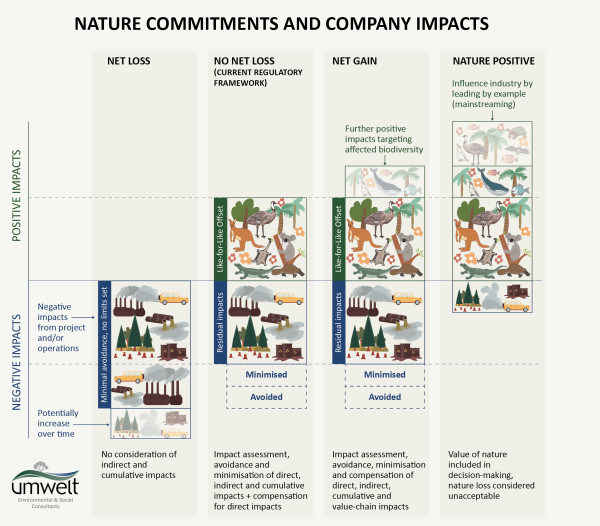The Relationship Between Offsets and Nature Positive

It's Biodiversity Month. Let's take a look at the relationship between Offsets and Nature Positive
A common response you get when you start talking about Nature Positive, what it means and what they can do to achieve a nature positive outcome, is:
“That’s great! We do some of that already with our offset sites. So that counts…right?”
The short answer is, not quite. Activities to manage, maintain or enhance biodiversity on an offset site do not count as being nature positive. Why? These are a compliance activity to compensate for removal, damage or modification of nature.
Nature Positive is a specific, measurable and ambitious transformative goal. It requires there to be more nature in 2050 than there is in 2020 with 30% of the globe protected or under restoration by 2030. To achieve this goal, a full range of actions will need to be implemented. The first of these actions is the need to reduce the amount of nature we are losing each day.
Why are offsets needed?
Australia has laws in place to reduce the impact that new projects and activities are likely to have on the environment. On top of the Environment Protection and Biodiversity Conservation Act 1999 that operates at a national level, there is state and territory legislation that regulates where and how actions that could have an impact on the environment are conducted, and what steps must be taken to gain approval to proceed with these actions.
Typically, this is done via impact assessment and approvals processes that sees the appropriate government agencies reviewing identified impacts. Then, they determine if actions have avoided, minimised and offset impacts to nature as much as reasonably possible (referred to as the mitigation hierarchy; see image below). Assuming the relevant government agency is satisfied that nature impacts have been minimised, mitigated and offset as much as possible, and the project is granted approval to proceed, compulsory conditions are usually imposed upon the proponent as part of the government approval and often these include mandatory offsetting obligations.
After an easy-to-understand explanation of offsets, why they may still equate to Net Loss of Nature, and thoughts on offsetting alternatives?
Watch this video from the University of Queensland: An alternative to biodiversity offsets: Target-based ecological compensation (youtube.com)

What are offsets and do they deliver No Net Loss or Net Gain?
Put simply, an offset is a compensation mechanism aimed at balancing out the impacts of development on biodiversity.
The theory is if we have a location where biodiversity is adversely impacted, we can take actions to improve biodiversity at a different location (achieving a commensurate gain in biodiversity). The result of this balance is “no net loss of biodiversity.” The figure below illustrates No Net Loss, Net Gain and Nature Positive (adapted from Maron 2024 (1) and The Biodiversity Consultancy).

Because the aim of an offset is to achieve a balance, actions associated with offsetting an impact to nature will never achieve a Nature Positive outcome. There is, however, potential to achieve Net Gain if:
- The offsets are successful
- They enhance the same values that are lost through an impact
- They’re based on correct metrics
- They do not count averted loss as an offset and
- They establish additional gains to compensate for uncertainty and other known offset failure issues
Nature Positive is more than Offsets
To achieve Nature Positive you need more than offsets. A system change is required, whereby nature is valued appropriately as necessary for our survival and as something we are a part of.
Nature is our life support system. And, once it is valued as such, we will inherently avoid causing loss of, damage to or negative impacts to it directly, through our purchases (supply chain), or indirectly, through the actions that we take that support other entities (down-stream value chain impacts).
We will also then do whatever we can to increase the extent and quality of nature as it will be built into our systems that recognise that investing in nature is investing in our own health.
Offsetting compensates for loss of nature. Nature positive requires us to embed the value of nature in our decision-making, goals, strategies, risk assessments and design. It is a societal goal that will see a revitalisation of nature, a reverse of the decline, an increase in ecosystems and abundance of native biodiversity, and correcting the economic frameworks that see nature as an externality. This may all sound unachievable and like a problem that is easier to defer, but our financial and business institutions tell us differently:
- World Economic Forum
- Pollination Group
- World Business Council for Sustainable Development "Pitch for Nature"

Want to know how to get started with assessing your nature-related risks, developing a nature positive strategy, integrating nature into your decision-making, incorporating nature-based solutions or you want advice about nature positive? Simply reach out to our Nature Positive Team via our enquiry form.
Want to talk to a trusted and experienced environmental approvals and biodiversity offset advisor? Simply reach out to our national Impact Assessment or Ecology Team via our enquiry form.
1. Maron M, Quétier F, Sarmiento M, ten Kate K, Evans MC, Bull JW, et al. ‘Nature positive’ must incorporate, not undermine, the mitigation hierarchy. Nat Ecol Evol. 2024 Jan;8(1):14–7.
